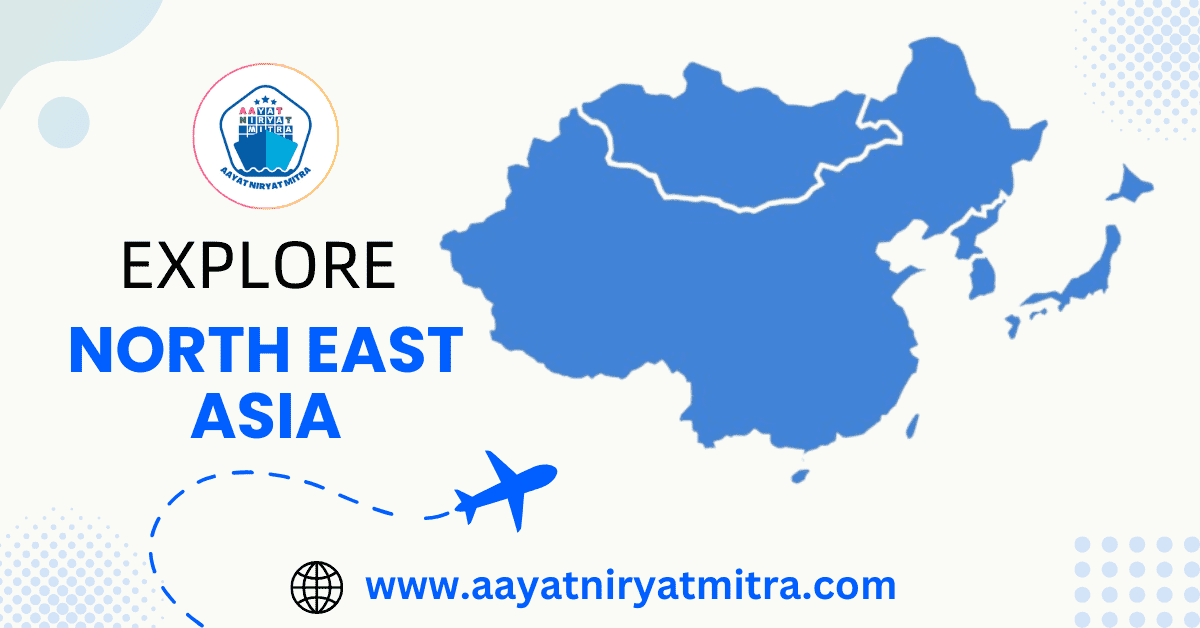India North East Asia Trade is important for India’s economic rise and has been significantly boosted by its growing trade relationships with North East Asia, including powerhouses like South Korea, Japan, China, and Taiwan. This region has become a vital economic partner for India. This blog explores the key aspects of India-North East Asia trade, focusing on its drivers, challenges, and prospects.
The Importance of North East Asia for India:
North East Asia is a global economic leader, known for its advanced technology, strong manufacturing base, and large consumer market. India’s strategic location and growing middle class make it an attractive partner for North East Asian businesses, leading to a mutually beneficial trade relationship.
Key Drivers of India-North East Asia Trade:
Several factors have fueled the growth of trade between India and North East Asia:
- Complementary Economies: India’s strengths in IT services, pharmaceuticals, and agriculture complement North East Asia’s manufacturing prowess, creating a win-win situation.
- Investment Flows: Significant investments from North East Asian countries into India’s infrastructure, manufacturing, and services sectors have strengthened economic ties.
- Free Trade Agreements (FTAs): India’s FTAs with South Korea and Japan have simplified trade procedures, reduced tariffs, and increased trade volumes.
- Geographical Proximity: Improved connectivity through air and sea routes has reduced travel time and costs, facilitating trade despite the physical distance.
Challenges and Opportunities:
While the trade relationship is promising, it faces several challenges:
- Trade Imbalances: India’s trade deficit with some North East Asian countries is a concern. Diversifying exports and promoting value-added products can help address this issue.
- Protectionist Measures: Protectionist policies in some North East Asian countries can hinder trade growth. India needs to engage in trade negotiations to protect its interests.
- Geopolitical Tensions: Regional geopolitical issues can impact trade flows. India must maintain a balanced approach to sustain strong trade relations.
These challenges also present opportunities for innovation and growth:
- Focus on High-Value Products: Shifting towards exports of high-value products and services can improve India’s trade balance.
- Infrastructure Development: Investing in port infrastructure, logistics, and digital connectivity can enhance trade efficiency.
- Skill Development: Upgrading the skills of the Indian workforce can attract more North East Asian investment.
- Diversification of Trade Partners: Reducing reliance on a few key markets can mitigate risks associated with trade fluctuations.
Success Stories in India-North East Asia Trade:
- India-South Korea: The IT and electronics sectors have driven bilateral trade.
- India-Japan: Collaboration in the automotive and manufacturing sectors has yielded significant results.
- India-China: Trade in pharmaceuticals, IT services, and agricultural products has grown substantially.
The Road Ahead:
The future of India-North East Asia trade looks bright. By addressing challenges and seizing opportunities, both regions can benefit immensely. Diversifying exports, improving infrastructure, and fostering innovation are essential for sustaining this growth.
Resources for Indian Exporters:
- Ministry of Commerce and Industry, India
- Federation of Indian Export Organisations (FIEO)
- Export Credit Guarantee Corporation (ECGC)
- Indian Trade Promotion Organisation (ITPO)
- Embassy and Consulates of India in African countries
North East Asia Countries Import from India:
India’s economic growth has been significantly influenced by its trade relations with North East Asia. This region, which includes major economic powerhouses, has emerged as a crucial market for Indian goods and services. Let’s explore India’s trade with each nation in this dynamic region:
- China: China is India’s largest trading partner. India’s main exports to China include pharmaceuticals, agricultural products, and IT services. However, the trade balance is heavily skewed in favor of China, highlighting a significant trade deficit.
- Democratic People’s Republic of Korea: Due to geopolitical tensions and international sanctions, trade between India and North Korea is limited. Despite these challenges, there is potential for future cooperation in areas like agriculture and infrastructure development.
- Hong Kong: Hong Kong serves as a vital financial and trade hub for India. Key Indian exports to Hong Kong include textiles, gems and jewelry, and engineering goods. The strategic location of Hong Kong makes it an important gateway for Indian products entering the broader East Asian market.
- Japan: Japan is a major market for Indian IT services, pharmaceuticals, and agricultural products. In return, India imports advanced machinery and technology from Japan, making it a crucial partner in India’s industrial and technological growth.
- Macao: While India’s trade with Macao is relatively small, it is growing steadily. Primary exports to Macao include textiles, gems and jewelry, and consumer goods, indicating a strengthening economic relationship.
- Mongolia: India’s trade with Mongolia primarily involves mineral resources and agricultural products. India exports pharmaceuticals, machinery, and consumer goods to Mongolia, fostering a mutually beneficial trade relationship.
- Republic of Korea: South Korea is India’s significant trading partner. India exports IT services, pharmaceuticals, and agricultural products to South Korea, while importing machinery, electronics, and automobiles, reflecting a well-rounded trade relationship.
- Taiwan: India’s trade with Taiwan is focused on electronics, machinery, and textiles. Key Indian exports to Taiwan include agricultural products and IT services, showcasing the diverse trade links between the two economies.
North East Asia | NEA Countries Buying From India:
India’s Total Export Value Apr, 23 – Mar, 24 / NEA $38.36 Bn
India’s exports to 8 countries/ territories in the NEA group across 31 commodities
| Commodity View | Total Exports Apr’23 – Mar’24 ($Mn) | % Share in selected criteria’s Total Exports |
|---|---|---|
| Engineering Goods | 8,253.45 | 21.51% |
| Gems And Jewellery | 7,114.78 | 18.55% |
| Iron Ore | 3,651.53 | 9.52% |
| Organic and Inorganic Chemicals | 3,228.62 | 8.42% |
| Petroleum Products | 2,986.82 | 7.79% |
| Others | 2,661.53 | 6.94% |
| Marine Products | 2,016.47 | 5.26% |
| Electronic Goods | 1,928.95 | 5.03% |
| Mica, Coal, And Other Ores, Minerals Including Process | 1,200.46 | 3.13% |
| Cotton Yarn/Fabs./Made-ups, Handloom Products Etc. | 1,041.22 | 2.71% |
| Spices | 1,037.30 | 2.70% |
| Drugs And Pharmaceuticals | 912.62 | 2.38% |
| Plastic And Linoleum | 480.78 | 1.25% |
| Ready-made garments of all textiles | 392.36 | 1.02% |
| Leather And Leather Manufacturers | 310.54 | 0.81% |
| Oil Meals | 278.45 | 0.73% |
| Man-Made Yarn/Fabs./Madeups Etc. | 124.22 | 0.32% |
| Fruits And Vegetables | 103.14 | 0.27% |
| Ceramic Products And Glassware | 97.86 | 0.26% |
| Oil Seeds | 87.52 | 0.23% |
| Cereal Preparations And Miscellaneous Processed Item | 74.55 | 0.19% |
| Handicrafts Excl. Hand Made Carpet | 72.43 | 0.19% |
| Tea | 55.2 | 0.14% |
| Meat, Dairy And Poultry Products | 51.19 | 0.13% |
| Cashew | 46.24 | 0.12% |
| Tobacco | 40.57 | 0.11% |
| Rice | 35.07 | 0.09% |
| Coffee | 33.89 | 0.09% |
| Carpet | 24.56 | 0.06% |
| Jute Mfg. Including Floor Covering | 11.34 | 0.03% |
| Other Cereals | 8.17 | 0.02% |
| Total | 38,361.83 | 100.00% |
FAQs on India North East Asia Trade:
-
Q: What is the significance of North East Asia for India’s economy?
Ans: North East Asia, which includes countries like China, Japan, South Korea, and Taiwan, is a key economic partner for India. It serves as a major market for Indian exports and is a significant source of investment and technological advancements for India.
-
Q: What are the major export products from India to North East Asia?
Ans: India primarily exports pharmaceuticals, IT services, agricultural products, textiles, and engineering goods to North East Asia. The exact mix of products varies across the different countries in the region, tailored to their specific demands.
-
Q: What are the key challenges facing India’s trade with North East Asia?
Ans: India’s trade with North East Asia faces several challenges, including trade imbalances, protectionist measures, and geopolitical tensions. Additionally, issues such as infrastructure bottlenecks and skill gaps can impede trade growth.
-
Q: What are the major opportunities for Indian businesses in North East Asia?
Ans: There are significant opportunities for Indian businesses in North East Asia in sectors like IT, pharmaceuticals, agriculture, and manufacturing. Potential areas for growth include collaborations, joint ventures, and technology transfers.
-
Q: How is the government of India supporting trade with North East Asia?
Ans: The Indian government is actively fostering trade with North East Asia through initiatives like Free Trade Agreements (FTAs), Lines of Credit, and diplomatic engagements. These efforts are aimed at creating a favorable business environment for Indian exporters.
-
Q: What are the major North East Asian countries for Indian exports?
Ans: China, Japan, South Korea, and Hong Kong are the primary destinations for Indian exports in North East Asia. Trade with other countries in the region is also expanding, indicating a broadening of India’s trade portfolio.
-
Q: What are the key sectors driving India-North East Asia trade?
Ans: The leading sectors driving trade between India and North East Asia include pharmaceuticals, IT services, and agriculture. Emerging sectors like automotive, electronics, and renewable energy are also gaining prominence in this trade relationship.
-
Q: How can Indian businesses benefit from FTAs with North East Asian countries?
Ans: Free Trade Agreements (FTAs) offer several benefits for Indian exporters, such as reduced tariffs, simplified customs procedures, and improved market access. These advantages can significantly enhance the competitiveness of Indian businesses.
-
Q: What are the cultural and business nuances to consider when doing business in North East Asia?
Ans: Success in North East Asia requires understanding cultural differences, building strong relationships, and adapting business practices to local markets. Respecting these nuances is crucial for establishing long-term business partnerships.
-
Q: What are the future prospects for India’s trade with North East Asia?
Ans: The future of India-North East Asia trade looks promising. With ongoing economic growth in both regions and supportive government policies, there is potential for a deeper and more balanced trade relationship.
Conclusion:
The trade corridor between India and North East Asia has become a cornerstone of India’s economic growth. By leveraging its strengths and tackling challenges, India can unlock the full potential of this partnership. As global economic dynamics evolve, policymakers and businesses must stay updated on trends and adapt their strategies. A future of robust trade, investment, and technological cooperation between India and North East Asia is within reach.
If you discover an error in the “Unlocking the Potential of India North East Asia Trade Corridor in 2024“ information provided to us, please notify us immediately via the comment box and email; if the information provided by you is correct, We will change it.
If you enjoyed this article, please share it with your friends. Please visit Aayat Niryat Mitra | Import Export Friend for more information on this and other topics. Thank you for stopping by.

